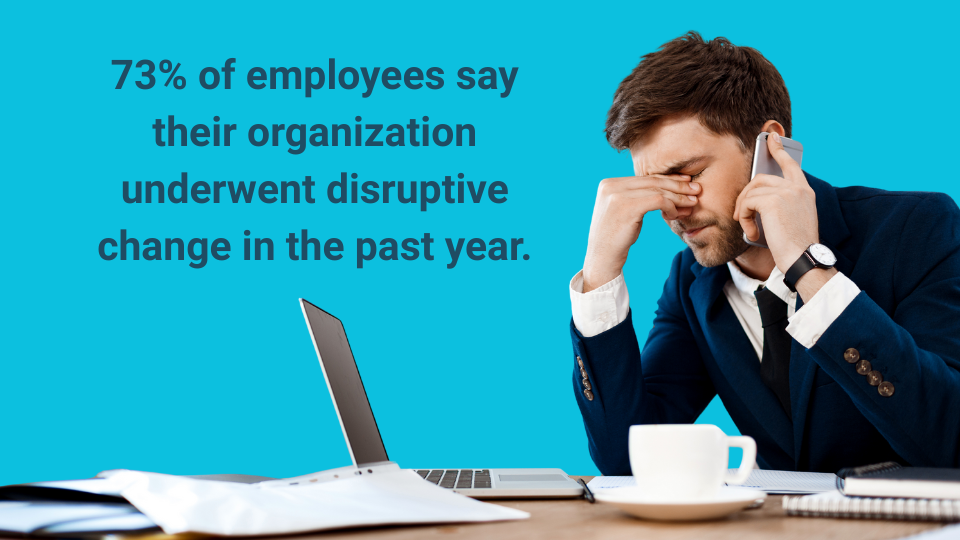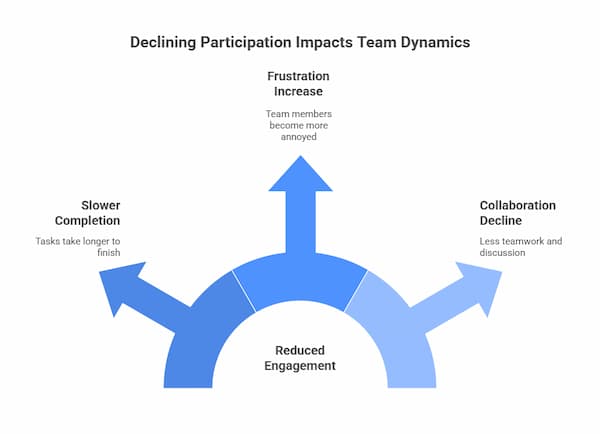Key Takeaways
- Understand Change Fatigue: Ongoing change drains focus and energy across teams.
- Spot Early Signs: Notice reduced motivation and curiosity before resistance grows.
- Lead With Humanity: Pacing and empathy keep transformation sustainable.
- Structure the Process: Clarity and coordination prevent overload.
- Use Technology Wisely: Tools should lighten, not lengthen, the workload.
Introduction: When Change Becomes Constant and Draining
In many organizations, change has shifted from occasional to constant. New systems and reorganizations appear quickly, leaving little time to adjust. The pace, meant to show agility, often leads to exhaustion and fading confidence.
At SentinelWave, a mid-sized firm, leadership launched several major initiatives over the past year. A new platform, restructuring, and updated performance systems all arrived quickly. Each promised progress, yet productivity slipped, deadlines were missed, and morale faded.
Employees were not resisting change but running out of the capacity to deal with it. Misreading exhaustion as opposition, leadership pushed harder and deepened the strain.
Recognizing that exhaustion is not opposition is the first step toward recovery. Once leaders see fatigue for what it is, they can begin to understand its causes and manage it with empathy and foresight.

What Change Fatigue Really Means
Change fatigue occurs when employees experience too much transformation without enough stability. It is not defiance; it is quiet disengagement. People still show up, but their enthusiasm fades as continuous shifts stretch their attention and energy.
To understand what was happening, SentinelWave’s leaders met to review results and uncover where change fatigue had taken hold. Teams met goals but stopped offering ideas, and silence replaced curiosity.
What they lacked was leadership connecting purpose to effort. The leaders saw that what looked like calm was really fatigue. They agreed to hold regular feedback sessions to spot disengagement sooner.
Leaders must look beyond output. When energy and curiosity fade even as work continues, it signals exhaustion, not contentment. The organization’s systems may still function, but people begin to disconnect from their purpose.
Understanding this distinction helps leaders shift from pushing compliance to rebuilding capacity. Once they identify fatigue, they can begin examining the root causes that sustain it.
The Hidden Causes of Change Fatigue
Change fatigue begins when leadership, process, and technology fall out of alignment. When these elements compete instead of connecting, even well-meant change creates confusion. Poor communication, conflicting priorities, and little recovery time drain energy faster than it can be restored.
Common contributors include:
- Overlapping priorities that compete for the same people and resources.
- Unclear communication that leaves employees guessing.
- Insufficient recovery time between initiatives.
- Disconnected technology that complicates daily work.
As the discussion continued, leaders mapped where fatigue began. Overlapping projects and late communication had stretched teams thin. To prevent this, they decided all new initiatives would follow a single intake process with clear sequencing and timing.
Many organizations face similar issues when timing, communication, and accountability fall out of sync. These overlaps cause teams to question priorities and dilute progress.
Recognizing these patterns enables leaders to identify early warning signs of fatigue and transition them into an effective strategy.
Recognizing and Reflecting on Fatigue
Fatigue rarely appears suddenly. It develops from small behavioral changes, including lower participation, slower responses, and reduced curiosity in daily work. Leaders who notice these shifts can intervene before engagement drops completely.
Later in the meeting, the team further reflected on signs they’d missed. Quieter meetings and fewer ideas showed disengagement, not focus. They realized people needed to feel led, not managed. To catch issues sooner, they committed to shorter check-ins and open forums for honest conversation.
Recognizing fatigue means observing both data and tone. Metrics like missed deadlines reveal strain, while quieter cues such as silence, sarcasm, or withdrawal signal deeper stress.
Early signs of fatigue often include:
- Declining participation in meetings or brainstorming sessions.
- Reduced initiative or slower task completion.
- Shorter attention spans and increased frustration.
- Withdrawal from collaboration or open discussion.
By combining observation with reflection, leaders convert information into empathy. That mindset becomes the foundation for leader readiness, where awareness turns into deliberate preparation for guiding sustainable change.

From Awareness to Action: Building Leader Readiness
Leader readiness is the stage between recognition and behavioral change. It transforms awareness into practical preparation. Leaders who reach this stage have already managed their own habits, ensuring that their teams see steadiness rather than reaction.
As discussion deepened, the executives admitted they’d modeled urgency instead of steadiness. Their reactions to setbacks caused anxiety. Each set two goals, like pacing initiatives better and communicating sooner, to guide teams through change more calmly next time.
Steps leaders can take to build readiness:
- Review where past initiatives overlapped or lacked clarity.
- Identify capacity gaps before launching new efforts.
- Communicate the “why” behind each change early and often.
- Personalize improvement goals to make accountability visible.
Readiness develops through feedback loops, clear communication, and the discipline to pause before acting. Leaders must weigh timing and capacity as carefully as results. When readiness becomes routine, change feels planned rather than improvised.
Readiness for SentinelWave was not about redesigning systems; it was about re-learning how to guide people through them.
Prepared leaders restore confidence. Their readiness sets the tone for consistency, paving the way for leadership practices that renew team energy and engagement.
Leadership Practices That Restore Energy
Leadership practices shape how employees experience change. Clear communication, steady pacing, and visible empathy rebuild trust and motivation after prolonged transformation, restoring the trust and rhythm that fatigue often erodes.
Continuing their reflection, leaders realized they’d prioritized speed over clarity, which had drained morale. They agreed that future initiatives would include recovery time, open progress updates, and recognition of team effort to restore trust and balance.
Leaders who sustain team energy tend to:
- Pace change to match team capacity.
- Explain the purpose behind each initiative.
- Create moments of rest and recognition between projects.
Effective leaders create momentum by aligning meaning and method. They connect every shift to the organization’s mission, emphasize participation, and celebrate adaptability as a success metric. These actions show that progress includes the people who make it possible.
When leadership steadies the emotional rhythm of change, energy returns naturally. This balanced approach lays the groundwork for effective processes that organize effort and alleviate daily strain.
Process Solutions That Make Change Easier
Processes determine whether change feels structured or chaotic. Clear frameworks turn ambitious goals into manageable steps, protecting employees from overload and giving teams the stability to move forward with confidence.
When the focus shifted to structure, managers reviewed how overlapping systems and poor timing had overloaded teams. They created a single readiness framework and required approval before new projects began, ensuring capacity stayed balanced across departments.
These refinements were not new systems, but instead renewed coordination between established processes, reliable technology, and the leaders who now managed both with greater care.
Strong change processes usually include:
- A visible roadmap showing project sequencing.
- Regular readiness checks before each launch.
- Governance to align timelines and resource use.
- Documentation that captures learning from each phase.
Mapping initiatives and checking readiness creates predictability and reduces disruption. A visible roadmap helps everyone see priorities, and readiness checks ensure timing supports adoption rather than exhaustion.
When processes provide both structure and breathing space, change becomes less about surviving transitions and more about sustaining improvement. Once timing is balanced, technology can enhance that rhythm instead of complicating it.
Using Technology Without Overwhelming People
Technology succeeds when it supports people’s focus and simplifies work. When new systems arrive too quickly or without a clear purpose, they introduce friction rather than efficiency. The goal is to make technology an ally to people, not a burden.
As discussion turned to technology, the group admitted they’d added too many tools too quickly. New platforms cluttered workflows and caused frustration. They agreed to simplify systems, test updates with employees, and pilot smaller rollouts to keep technology useful.
When evaluating new tools, leaders should:
- Audit overlapping systems before approving new ones.
- Ask end users what slows them down.
- Pilot small, measurable improvements before full rollout.
- Reassess tools annually to prevent bloat.
When technology aligns with how people work, it strengthens adaptability. That integration supports a culture where learning continues and change feels like progress, rather than pressure.
Building a Culture That Sustains Change
Sustained adaptability depends more on culture than on policy. A healthy culture views reflection and recovery as integral to performance, not as interruptions to it. Stability between initiatives allows employees to rebuild capacity and carry lessons forward.
Near the end of the meeting, the group shifted its focus to company culture. Teams followed instructions but rarely reflected on their work together, resulting in lost lessons. Leaders agreed to add retrospectives, share insights openly, and track engagement to sustain balance.
Leaders also committed to incorporating these practices into ongoing leadership development, ensuring reflection became part of everyday learning.
Cultural habits that sustain adaptability:
- Schedule structured retrospectives after major milestones.
- Encourage open dialogue without penalty for honest feedback.
- Share lessons learned through accessible knowledge hubs.
- Recognize flexibility as a sign of professional growth, not indecision.
When organizations institutionalize learning, they replace fatigue with resilience. This steady mindset naturally leads to the broader leadership traits of empathy and foresight, which sustain progress over time.
Embedding reflection into team routines became a new form of training, helping leaders and employees learn together how to sustain focus without losing momentum.
Leading With Empathy and Foresight
Empathy and foresight are the leadership traits that transform change management into long-term growth. Empathy ensures that leaders stay attuned to capacity, and foresight allows them to plan transitions that respect it. Together, these qualities foster endurance rather than exhaustion.
Months later, the impact of that meeting was clear. SentinelWave’s leaders struck a balance between innovation and pacing and demonstrating empathy. Employees now described change as purposeful and steady, proof that reflection had turned exhaustion into progress.
At SentinelWave, change no longer felt relentless. It felt guided.
Organizations that lead with empathy and foresight sustain both morale and performance. They anticipate pressure points early and act before fatigue takes hold. These quiet, thoughtful habits build lasting trust, even when priorities inevitably shift.
When leaders manage capacity as carefully as they manage strategy, change becomes constructive. The result is growth that lasts because people and systems evolve together.
Sustainable leadership requires practice and reflection, not just intention. At Watermark Learning, we help organizations build leadership and change-management skills that sustain clarity, compassion, and confidence. Strengthen your leadership capacity to create a workplace where change feels constructive, not constant.
Jay Pugh, PhD
Dr. Jay Pugh is an award-winning leader, author, and facilitator with over 18 years of teaching and training experience. Currently serving as Head of Leadership Growth at Educate 360, he leads a robust team of external and internal facilitators who specialize in developing leadership capabilities within medium and large-scale businesses. His team works directly with business professionals, helping them become more effective leaders in their daily operations.
Dr. Pugh holds a Ph.D. in Instructional Management and Leadership, and his academic contributions include two published articles and a dissertation focusing on various educational topics. His extensive experience and academic background have established him as a respected voice in leadership development and educational management.

 New Horizons
New Horizons
 Project Management Academy
Project Management Academy
 Six Sigma Online
Six Sigma Online
 Velopi
Velopi
 Watermark Learning
Watermark Learning
 Login
Login





 New Horizons
New Horizons
 Project Management Academy
Project Management Academy
 Velopi
Velopi
 Six Sigma Online
Six Sigma Online
 Watermark Learning
Watermark Learning